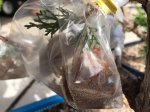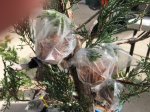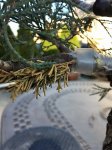DrBonsai
Mame



See: https://www.bonsainut.com/threads/juniper-whip-splice-tongue-grafts.26610/
In early March I made 12 grafts of itoigawa foliage on to Juniperus scopulorum.
They all stayed green until July, then there appeared to be some browning of some grafts.
I kept the bags on until September and made sure the moss stayed moist.
I cut open the bags but left remnants to hold moss and moisture when watered.
Yesterday I removed the bag remnants and parafilm tape holding the grafts in place.
My results were as follows:
Out of 12 grafts, MAYBE 4 were successful.
4 appeared to graft and were attached but had brown foliage.
4 appeared to be loose, no graft or attachment at all and brown.




The apparently successful grafts were all on the upper branches of the tree.
My possible conclusions were that either grafts are more successful on smaller, younger apical branches and/or
I had more practice on the latter more apical grafts and demonstrated more practiced technique working my way up the tree.
Does anyone have an opinion on the class of grafts that appeared to "bond" to the tree but yet appeared brown or dead ?
Do you think the grafts were initially successful but then died due to excessive heat in summer or other reason ?
